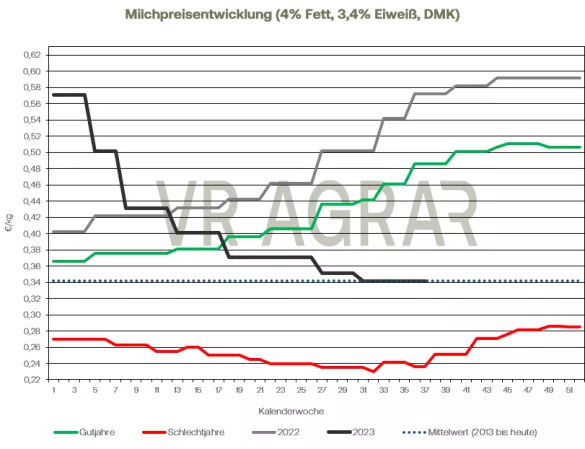The seasonal decline in milk supply has paused for the longest time in a row. Around 0.2% more milk was served in the 36th calendar week than in the 35th calendar week. This was also already larger in quantity than the 34th calendar week. Overall, the dairies have less milk available than, for example, in August or July. Cream prices were able to increase again due to the scarcer milk supply and good demand; industrial cream is also in good demand with firmer prices. Skimmed milk concentrate is traded at stable prices. Spot market milk increased again and is valued by the ife Institute in the federal average for the 37th calendar week at 43.1 cents/kg, which is 0.4 cents/kg higher. In the Netherlands and Italy, however, spot market prices are already trending downwards again. The volume of molded butter ordered has decreased slightly compared to the previous week, but remains at a high level. The high temperatures in recent weeks have had a dampening effect on demand, although manufacturers are satisfied with sales. The prices in Kempten remained stable this week at 4.64 to 4.85 euros/kg. .The block butter market remains calm overall. However, manufacturers' price demands are increasing because cream has also recently become significantly more expensive. In many cases, cream is not processed into butter but is sold directly. Accordingly, the supply of fresh goods has decreased. However, the higher price demands are not yet reflected in the deals. The butter and cheese exchange in Kempten recorded an unchanged trading range of 4.40-4.60 euros/kg. At the Global DairyTrade tender on Tuesday, butter rose by 3.8 percent to the equivalent of 4,409 euros/t. Despite the price increase here, domestic goods remain only very competitive on the international market to a very limited extent. On a weekly basis, contracts on the EEX also increased. The trading volume here has been lower recently. Semi-hard cheese continues to be traded and purchased actively. However, as with molded butter, volumes have declined slightly at the consumer level. There is a lot of interest in varieties that are advertised by food retailers and have promotional prices. This is currently particularly evident with mozzarella, for example.Large consumers and industry mostly call up their quantities within the agreed volume, but here and there they also show interest in additional short-term deliveries, which not all dairies can meet. Because inventories are still below average and relatively young. As expected, orders and deliveries from the classic southern European holiday regions are declining. Prices in Hanover remained constant for both block and bread goods. The powder markets continue to appear busier, although the market is still described as calm. Inquiries for skimmed milk powder are arriving at the plants, new contracts are limited in both the domestic and foreign markets. Recently, the production of goods has decreased, which is why suppliers mostly had no pressure to sell. This subsequently led to firmer contract prices being enforced for short-term deliveries. However, for later deliveries, the bid and ask prices are far apart. Price trends on the EEX also showed slightly firmer trends this week.The cash market quotation on the South German Butter and Cheese Exchange increased by 30 euros at the lower end and by 20 euros at the upper end. At the GlobalDairyTrade tender in New Zealand, skimmed milk powder also increased and is approaching European prices with a converted rate of 2,240 euros/t. Feed qualities were able to trend higher in yesterday's prices. Whole milk powder is once again standing still both in terms of the quantities traded and in terms of price developments. Additional deals, if at all, are mainly concluded for short-term deliveries. Despite increasing international prices, European whole milk powder remains too expensive on the world market. On the other hand, the prices for whey powder were firmer. Demand has increased, even if not every conversation results in a deal. The Kempten price rose particularly at the lower end of the trading range.

ZMP Live Expert Opinion
The decline in milk volumes is pausing, and major customers are still cautious on the market. Nevertheless, prices for block butter and skimmed milk powder increased slightly overall. The development of the EEX also indicates rising prices. All in all, the milk market is in a stable condition.


